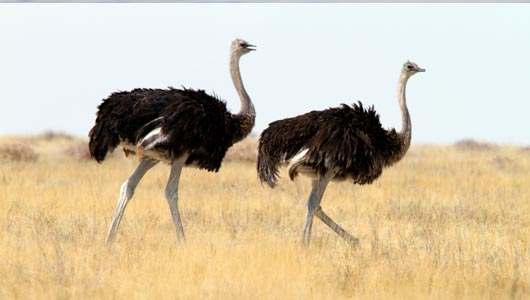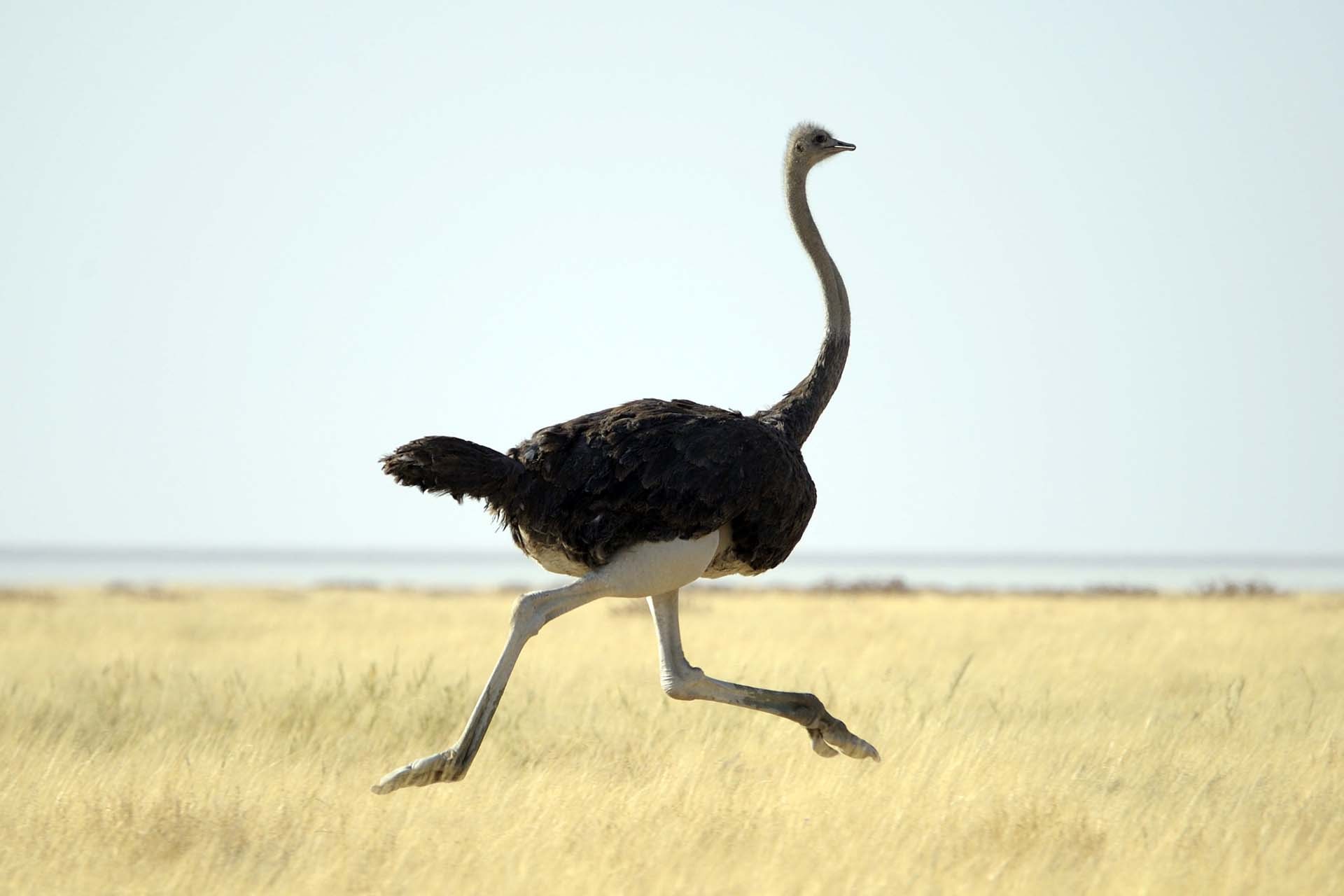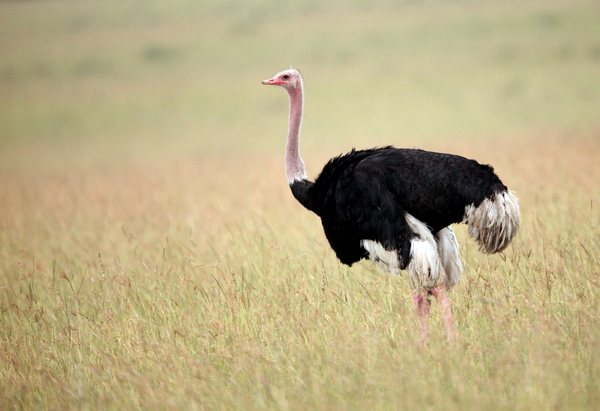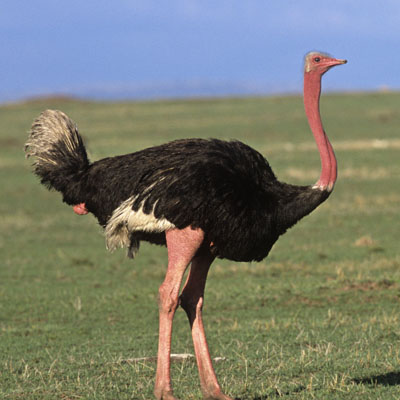
Ostriches belong to a striking group of flightless
birds known as ratites, that also includes
emus, cassowaries, rheas, and kiwis. Ratites have
flat, smooth breastbones that lack a keel to which
flight muscles could attach. They are thus unable
to fly, and have weak wing muscles. They do use
their wings, spreading them out to help them cool
off, and also to splash water when bathing. Ratite
feathers are different from those of flying birds.
The individual strands are not interlocked, and
thus they are soft and billowy and air passes right
through them. Their plumes have long been admired
by humans and used for decoration and
adornment. As with other birds, their feathers
function as protection from the elements, and
ratites preen, spreading waterproofing oil to their
feathers with their beaks. They also molt once a
year. Ratites have heavy, strong bones and powerful
leg muscles, and are able to run swiftly. They
are omnivores, feeding on a variety of grasses,
plants, seeds, fruit, insects, and small animals.
There are many farms in the United States that
raise ostriches, emus, and rheas for their feathers,
hide, meat, and oil. In their native countries,
ratites are hunted or raised for their feathers and
as food. Ostriches have also been tamed for riding
and for pulling carts.
Ostrich Characteristics
Ostriches have long necks and legs and are the
largest living birds. Males stand eight feet tall, and
weigh three hundred pounds. The ostrich can take
strides of twenty-five feet and outrun pursuers at
speeds of forty miles per hour. If cornered, the ostrich
has a powerful kick that can maim an enemy.
It has two toes on each foot, and a razor-sharp toenail
that both grips the ground while running and
can slash the flesh of its enemy.
Male ostriches are black with white plumes on
their tail and wings. Females are grayish-brown.
The head and legs are featherless. The neck is covered
with down and is red or grayish. The ostrich
has huge eyes with long protective lashes and has
keen eyesight for spotting danger a long way off.
It can make loud hissing and roaring noises.
Ostriches are native to Africa; they are nomadic
and graze on open savanna. They often follow
herds of zebras or antelope, catching insects
and small animals stirred up by their hooves.
They swallow sand and stones to help grind up
their food. Contrary to popular belief, they require
a regular water supply.
When mating, male ostriches make a booming
call and perform a courtship dance for the females.
They are polygamous, taking three or more
hens as mates. The male scratches a shallow pit
into which each female lays up to a dozen eggs, for
a total clutch size of up to thirty eggs. This communal
nesting behavior is unusual among birds.
The male shares incubation with one dominant female.
The male sits at night and the female during
the day. Ostriches lay the largest eggs of all living
birds, seven inches long and three pounds. The
eggshell is very tough and hard for predators to
crack open. The parent will sometimes lay with its
neck outstretched on the ground when danger
threatens, giving rise to the legend that they bury
their heads in the sand. They may also feign injury
to lure predators away from the nest. Newborn
chicks are precocial and instinctively know how
to search for food. They are full adults by three
years of age.
Ostrich Relatives
Rheas live in flocks on grasslands in South America.
They are similar to ostriches in behavior and
appearance, although they
have three toes on their feet, as
do most of the other ratites.
They are brownish in color
and can be five feet tall. They
are polygamous, but only the
male incubates the eggs.
Emus live on plains in the
Australian outback, and flock
nomadically according to rainfall
patterns and the resulting
food supply. The emu is the
second largest flightless bird,
nearly six feet tall and eightyfive
pounds. It has brownfeathers
and a loose, moplike tail.
Emus are monogamous.
Cassowaries live in the rain
forests of New Zealand and
northeastern Australia. They
are solitary and territorial,
pairing only to mate. They
feed primarily on fruit fallen
from trees. Cassowaries have
black, loosely hanging feathers,
and the wings are composed only of quills.
They have bright blue heads and colorful wattles.
A distinctive bony crown on the head called a
casque helps them push through the dense forest,
and is also used to turn over litter in search of
food.
Kiwis are elusive, nocturnal birds that live in
the forests of New Zealand. They are the smallest
ratites, about the size of a chicken. They have
round, brown-feathered bodies, short legs, four
toes, and run by placing one foot directly in front
of the other. Their long, slender beaks have nostrils
at the very tip, and are used to probe the
ground to locate worms, beetles, spiders and larvae
by smell. Males have a shrill, whistling mating
call. Females lay only one or two eggs that are
enormous in proportion to their body size.
Ostrich Facts
Classification:
Kingdom: Animalia
Phylum: Chordata
Subphylum: Vertebrata
Class: Aves
Orders: Struthioniformes
Families: Struthionidae
Geographical location: Southern Hemisphere-Africa
Habitat: Semidesert and open plains
Gestational period: One breeding cycle per year; incubation varies
from forty days to eighty days
Life span: Ostriches average forty years in the wild, up to eighty years
in captivity
Special anatomy: Unkeeled breastbone, tiny wings, unbarbed feathers,
solid bones, strong muscular legs
Other popular Animals
Photo Gallery of - Ostrich








 Animalia Life
Animalia Life